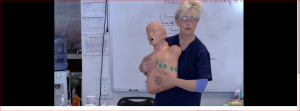Metastatic Breast Cancer Awareness Day
Author: Nancy Lydia Kimmel, RN, BS, MSN, Family Nurse Practitioner Board Certified.
Welcome to the Phlebotomy Career Trainings News Post! Today, we want to shed light on a topic that deserves our attention – metastatic breast cancer. Over the past 15 years, Phlebotomy Career Training has graduated hundreds of students in many specialized fields, such as clinical medical assistant, phlebotomy technician, electrocardiogram technician and IV technician. As a medical health career training school we want to reach out to our students and remind them to take care of their own health as they would their patient’s and family members health.
Breast cancer It’s a disease that affects countless lives and has the potential to spread if not caught early enough. As future healthcare providers, it is crucial for us to be aware of this risk and remind our loved ones about the importance of regular checkups and self breast exams. So, let’s dive in and explore why raising awareness about metastatic breast cancer is so vital.
What is metastatic breast cancer?
Metastatic breast cancer is the spread of breast cancer to other parts of the body such as the brain, lung,, lymph nodes and bone.
https://www.cancer.org/cancer/risk-prevention/sun-and-uv/skin-exams.html
Metastatic breast cancer is a term that describes the spread of breast cancer beyond the breast tissue. When breast cancer cells break away from the primary tumor and travel through the bloodstream or lymphatic system, they can settle in other parts of the body such as the brain, lungs, lymph nodes, and bones.
Once these cells reach a new location, they can continue to grow and form secondary tumors. This process is known as metastasis. It’s important to understand that metastatic breast cancer is not a separate type of cancer but rather an advanced stage of invasive breast cancer.
The spread of breast cancer to distant sites can have serious consequences on a patient’s health and overall prognosis. It requires comprehensive treatment approaches involving both radiation therapy and chemotherapy to target and control the growth of these secondary tumors.
https://www.medscape.com/viewarticle/995572?src=dpcs
While early detection plays a crucial role in preventing metastasis, it’s equally essential for healthcare professionals like our students to educate their patients about self-examinations, regular check-ups, and mammograms. By being proactive in raising awareness about this aggressive form of breast cancer, we can potentially save lives by catching it before it spreads further.
Importance of Raising Awareness
Being aware and taking steps toward prevention is crucial to catch breast cancer early and stop it from spreading.
Raising awareness about breast cancer is not just a trendy topic, it’s a matter of life and death. Being aware of the signs and symptoms can help catch breast cancer early on when treatment is most effective. By taking steps toward prevention, we have the power to stop this disease from spreading.
Breast cancer affects millions of women around the world, and early detection is key to improving survival rates. Regular check-ups with your doctor and performing self-breast exams monthly are simple yet crucial actions that can make all the difference.
The importance of raising awareness cannot be overstated. Education empowers individuals to recognize potential warning signs and seek medical attention promptly. It also encourages proactive measures like maintaining a healthy lifestyle, which can significantly reduce one’s risk.
By spreading knowledge about metastatic breast cancer, we bring attention to its potentially devastating consequences if left untreated or undetected. Through education campaigns, community events, and support groups, we create an environment where people feel comfortable discussing their concerns openly.
Remember: prevention starts with awareness! So let’s join forces in educating ourselves and our loved ones about breast cancer risks, symptoms, screening methods – every bit of information counts in saving lives.
Signs and Symptoms to Look Out For
Signs and symptoms of breast cancer can be very insidious such as palpating or noticing a lump that doesn’t move, bleeding from the nipple or puckered skin around the areola. The puckered skin is called ,”Peau d Oranage'”
Signs and symptoms of breast cancer are not always obvious, which is why it’s important to be aware of the subtle changes in our bodies. One common sign to look out for is the presence of a lump that doesn’t move or change shape. While not all lumps are cancerous, it’s essential to have any unusual masses checked by a healthcare professional.
Another potential symptom is bleeding from the nipple, which can occur spontaneously or with slight pressure. This can be alarming and should prompt further investigation. Additionally, some individuals may notice puckered skin around their areola, resembling the texture of an orange peel. This condition is known as “Peau d’Orange” and may indicate an underlying issue.
It’s crucial to recognize that these signs and symptoms do not automatically confirm a breast cancer diagnosis. However, they serve as red flags that warrant medical attention. Regular self-exams and routine check-ups with your healthcare provider can help catch any abnormalities early on.
Remember, everyone’s body is unique, so pay attention to what feels normal for you. If anything seems off or different from your usual state of health, don’t hesitate to seek medical advice promptly.
Self Breast Exams monthly!
Performing self breast exams monthly can help you catch a lump early. But be sure not to do a self breast exam a few days before or after your menstrual cycle. It is better to wait a least 7 days after your menstrual cycle completely ends. For women in menopause, you should perform self breast exam on the same day every month.
About the Author: Nancy Lydia Kimmel holds her Associates in Applied Science in Nursing from Henry Ford Community College, and her MSN as a Family Nurse Practitioner from Walden University. She is the author of several books on Phlebotomy, Electrocardiogram and The Nursing Entrance Exam Study Guide.


Nancy L. Kimmel obtained her PhD in Environmental Engineering in 2002, then went on to teach Physics and Mechanical Engineering at Lawrence Technological University, Henry Ford College and Oakland University. She obtained her Associate in Nursing from Henry Ford College and then went on to earn her Master Degree as a Family Nurse Practitioner and became Board Certified working as a licensed FNP in the State of Michigan. She then went on to Medical School where she is now in her 3rd year, and is also in the process of obtaining her Doctorate in Nursing Practice through Chamberlin University. She has authored the NET Study Guide, as well a several books on subjects of Math, ECG/EKG and Phlebotomy. She holds a patent on an Air Filter through the U.S. Patent Office.

